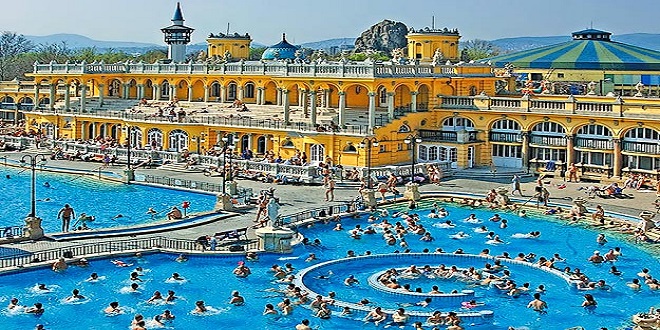Budapest, with its healing waters, has just met its match in the rejuvenated spa city of Bath

Budapest is commonly seen as a kind of nirvana for spa-lovers. Since the invading Ottoman Turks introduced communal bathing to Central Europe in the 16th century, Hungarians have embraced the culture as their own. Such a mythology has built up around this city that it’s easy to forget there are many equally great spa towns found around Europe. One example is the city of Bath in the heart of England’s West Country, whose long history of bathing dates back almost 2,000 years to when the Romans built the first baths here. The city underwent a revival in the 18th century when people flocked to its reputedly healing waters, but gradually interest waned and in 1978 the baths were closed due to lack of funding and a health scare. Today, the UNESCO World Heritage City of Bath is seeing another revival following the opening of a new spa that throws down the gauntlet to Budapest.
It is a monument to luxury, with five floors of pools, steam “pods,” and treatment rooms. Take its rooftop facility: on a cool evening, thick clouds of steam rise and part to reveal a clear pool dotted with swimmers immersed in its warm, mineral-rich waters. There’s no better way to unwind than lingering in the gentle Jacuzzis here while surveying the rooftops of creamy Georgian buildings glowing in the sunset, as pigeons fly past at eye level.
Main city sights
Roman Baths and Pump Room
The original Bath spa is fascinating to visit. Built as a temple and sanctuary in around AD 70, the ruins are in very good condition, with Roman plumbing that still works. The adjoining 18th-century Pump Room, once a rest center for the sick, is now a daytime restaurant that offers spa water on the drinks menu.
Royal Crescent
This sweeping semi-circle of elegant Georgian buildings is the architectural pride of Bath. Of the 30 houses designated most historic, the two central buildings are now occupied by the luxurious Royal Crescent Hotel.
Bath Abbey
The 15th-century Abbey Church of Saint Peter, with its 52 stained-glass windows and magnificent fan-vaulted ceiling, is the West Country’s finest example of Gothic Perpendicular architecture. Climb the tower’s 212 steps for fantastic city views.
Pulteney Bridge
Built for businessman Sir William Pulteney by Robert Adam in 1773 to develop the Avon’s east bank, this is one of only four bridges in the world that is lined with shop buildings. Below it, the river drops down an attractive weir.
Practical information
Getting There and Around
The nearest airport is just outside Bristol, 20 miles (32 km) northwest of Bath, but most international visitors will come via London Heathrow Airport. Bath is well served by national trains and regional buses and is 10 miles (16 km) from Junction 18 of the M4 motorway.
Where to Eat
The food scene is well established in Bath, where there are several award-winning restaurants and a multitude of independent and chain restaurants serving all kinds of cuisine. The Hole in the Wall is a great choice offering modern British cuisine. Some of the country’s top chefs trained here, yet it’s remarkably good value, with meals for US$45 per head.
Where to Stay
When to Go Any time of year, but avoid the height of summer, when Bath gets busy. Britain’s weather is changeable, but in the Thermae rooftop spa, it doesn’t matter too much what the weather is doing.
Budget per Day for Two Around US$500 for your hotel, a 2-hour spa session and meals. There are no travel costs as all sights can be reached on foot.
Last word
Bath is also renowned for its splendid Georgian architecture, and has a thriving pub and club scene to which its Central European counterpart can only aspire.





